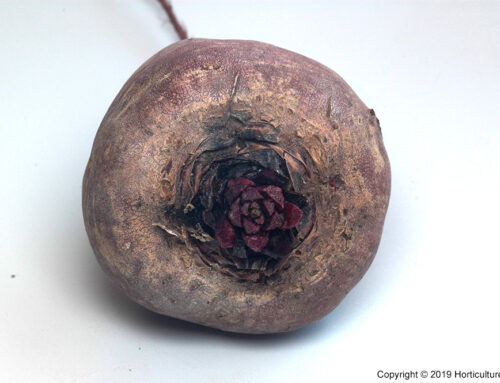Beetroot mechanical weed control
Weeds are controlled either by hand or chemically. Since beetroot seed is actually a small fruit with 2-6 seeds inside, the bunches of seedlings are thinned out so that only one seedling is left and at least 75mm apart.
One of the biggest problems with weeds is that they compete with the small seedlings for light, water and nutrition. So for good quality yields, weeds must be controlled early on. Clean and shallow cultivation is recommended. Be careful though, the secondary roots of the plants are shallow and mechanical cultivation can damage them. So weeds must be removed before the seedlings emerge with mechanical implements but must be removed by hand once the plants emerged.
Chemical weed control in beetroot
Although chemical weed control is more effective and less costly than labour, any error during the process can be devastating to the yield. The other disadvantage is there is a steep learning curve using chemical weed control. You need to know about concentration of chemicals and how it works. You need to know about flow rate of your system in order to calculate the correct application of the weed killers. Then there is the whole system of health and safety regarding storage and handling of these dangerous chemicals.
There are two chemicals registered to control weeds in field grown beetroots:
Chloridazon (Pyramin)
Chloridazon is applied after planting but before emergence. It must be applied to a moist soil to be effective. So apply either after good rainfall or after irrigation. Apply the chemical as soon after planting as possible as any contact with the leaves of the seedlings will cause damage and a reduction of yields. Some varieties are more sensitive to Chloridazon than others. So expect some loss of seedlings with Crimson Globe for instance.
All chemicals are sensitive to pH, organic soil content, clay content, temperature and humidity. Pyramin applied during warm conditions will result in poor weed control and possible lower yields.
Chloridazon is designed to control most annual broadleaf weeds. The following weeds are controlled”
- Quick weed such as Galinsoga parviflora
- Pig weed – Amaranthus spp.
- Cow thistle Sonchus spp.
- Purslane – Portulaca oleracea and
- Blue grass – Poa annua
Goosefoot Chenopodium spp. and goose-grass Eleusine africana are fairly well controlled.
Weeds not controlled at all are those with bulbs, runners or other storage organs such as nutgrass (“uintjies”).
The required strength or concentration of the weedicide will depend on the type of soil. On sandy soils 2 kg/ha is strong enough compared to clay soils a concentration of 4 kg/ha is required. On very sandy soils the concentration can go as low as 1 kg/ha.
After Pyramin application, no other crops except beetroot or swiss chard can be planted on the same field for the next 3 months. Flood irrigation reduces the effectiveness so sprinkler irrigation is recommended. Flood irrigation leaches out the active ingredient of Pyramin. It is also possible that plants lower down in a flood irrigated field are damaged due to an increase in Pyramin concentration above that what is recommended.
Sethoxydim (Nabu)
Nabu is a post emergence herbicide for the control of annual grasses only. It must be applied when the grass is in the 2nd leaf to 3rd tiller stage. So they must be very young and small. Beetroot is tolerant to this chemical so it can be applied at any growth stage.






Leave A Comment
You must be logged in to post a comment.